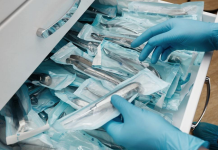
The global sterile and antiviral packaging market size is estimated to reach USD 25.7 billion in 2024 and is anticipated to reach a value of USD 37.5 billion by 2034. Sales are projected to rise at a CAGR of 3.8% over the forecast period between 2024 and 2034. The revenue generated by sterile and antiviral packaging in 2023 was USD 24.6 billion. The industry is anticipated to exhibit a Y-o-Y growth of 4.6% in 2024.
Sterile and antiviral packaging solutions made up of plastic are used on a large scale in the surgical and medical industry, capturing more than 50% of the total market share. There are medical equipment such as pre-filled syringes, tubes, catheters, lancets, bandages, and gloves packaged in plastic pouches.
The major reason behind using plastic instead of other materials is the ability of plastic to go under sterilization. These critical equipment pass the sterilization process in various stages to ensure that it is free from any type of bacterial, or microbial contamination.
The pharmaceutical and biological industry is set to capture around 50% of the total market share, further expanding at a 4.5% growth rate in the assessment period. The biological industry consists of critical products, which include vaccines, blood and blood components, somatic cells, gene therapy, tissues, and recombinant therapeutic protein.
The preservation of such products during storage and transport is very necessary to sustain their effectiveness. With the motive of sustaining the effectiveness of biological products, safe and antiviral packaging solutions such as pouches having an adhesive seal that offers liquid-tight, secure sample closure are required.
The sterile and antiviral packaging market is set to experience profitable growth during the forecast period. It is projected to create an incremental opportunity of USD 12.9 billion and is predicted to rise 1.5 times the current value through 2034.
Key Industry Highlights
Rising Concern towards Spread of Infections during Medical Treatments
The sterile and antiviral packaging market is considered to be the most accelerating market in the pharmaceutical and healthcare industry. The rising prevalence of infectious and non-infectious diseases or viruses such as Corona, Ebola, and others are supplementing the market growth. With time, the types of infections, diseases, and their method of treatment have been changing on a large scale. To stop the spread of infectious diseases, organizations are raising awareness about the steps that need to be taken to prevent infectious diseases.
Increasing demand for protective packaging solutions to prevent the spread of infections by anesthesia equipment, laryngoscope blades, blood pressure cuffs, stethoscopes, and oxygen saturation monitors is propelling the sterile and antiviral packaging market.
According to the study by Amcor Plc, a global packaging company, medical pouches are excellent for packaging medical equipment. Bags and pouches are used prominently for packaging medical apparatus such as canisters, hypodermic needles, thermometers, aspirators, and nebulizers.
Sterilized packaging is an essential component of the medical industry as it can be life-threatening to patients. Increasing pressure from regulatory authorities dealing with the medical and pharmaceutical industry is boosting the sales of sterile and antiviral packaging.
Increasing Demand for Secured Packaging in the Food and Beverage Industry Pushes Sales
A rise in the consumption of packaged foods and beverages across regions is pushing the sale of sterilized and antiviral packaging. The consumption of spoiled, contaminated, and damaged foods and beverages leads to various types of food-borne diseases.
This has generated a necessity for sterile and antiviral packaging solutions with the objective that packaged foods, and beverages reach the customers pure in quality and safe. Packaged food and beverages have to face severe situations after their production phase during storing, warehousing, transport, and distribution.
Sterile and antiviral packaging is the most crucial aspect to keeping the products safe for human consumption and free from contamination due to exposure to excessive sunlight, moisture, and other external factors. Packaging solutions of multiple materials can be made as per the desired product and demand of the end user.
Materials like plastic, glass, metal, paper, and many more offer effective sterile and antiviral packaging solutions for a wide range of food and beverages. Various organizations are stepping ahead to provide sterile and antiviral packaging solutions.
The Environmental Protection Agency (EPA) stated that antimicrobial technology be built into plastic and textiles used in food packaging to prevent the growth of bacteria, mold, mildew, fungi, discoloration and odor. Companies are investing and developing suitable materials that continue with antimicrobial costing is emerging as a trend in the industry.
A study has been going on the development of edible food packaging that can create traction in the packaging industry of food and beverage.
High Production Cost to Hamper the Demand for Sterile and Antiviral Packaging
In the current scenario, there are very few sterile and antiviral packaging manufacturers in the market. These packaging solutions are associated with different types of added costs , such as environmental, safety, and regulatory barriers, which lead to increased costs of the packaging solutions. Thus, high production costs have been a current challenge for the sterile and antiviral packaging industry.
Country-wise Insights
Rising Healthcare Expenditure in India is Propelling the Demand
The sterile and antiviral packaging industry in India is projected to create an incremental opportunity of USD 975.6 million over the forecast period. The country is estimated to hold more than 41% share of the South Asia region by 2034. The post-pandemic period has opened eyes regarding the precautions to be taken for the prevention of infections.
Infectious diseases like dengue, hepatitis, and flu can be life-threatening if necessary precautions are not taken. Individuals have become aware of their health safety, which has led to a high demand for sterile and antiviral packaging, as effective packaging can help prevent such infections.
Rising Food and Beverage Industry in New Zealand
New Zealand’s food and beverage manufacturing sector offers a lot of opportunities for the market. The country is anticipated to hold a value share of 34.8% in 2034 and record a CAGR of 3.3% during the valuation period. The food and beverage manufacturing industry is one of the prominent sectors in New Zealand, accounting for a significant share of total manufacturing income. This is resulting in sales generation in the domestic retail food, grocery, beverage, and products market in New Zealand.
The food and beverages industry in New Zealand registered a Y-o-Y increase of 3.6% in 2024. The packaging is responsible for eliminating spoilage of the product and preserving the product’s shelf life. For instance, food and beverage manufacturing companies are using heat-shrink packages for meat products and aluminum cans possessing tamper-evident features for beverages to prevent their deterioration when exposed to heat.
Rising Flexible Packaging Industry in the United States to Drive Sterile and Antiviral Packaging Adoption
The USA is projected to showcase a CAGR of 3.5% in the forecast period. The growing flexible packaging trend in the country is projected to play a significant role in pushing demand for sterile and antiviral packaging solutions.
The preferences of customers are showing transition with time, and to satisfy their demands, the companies have been forced to offer flexible packaging solutions with variety in size, shapes and capacity. For instance, beverage manufacturers offer carbonated drinks in a wide range of pouches ranging from 100ml, 200ml and 250ml.
By presenting their products with variations in capacities, the companies have been able to cater to customers across all groups as per their food, eating habits, and appetite.
Flexible packaging is likely to be a dominant packaging segment in the country, accounting for a significant share of the total packaging market in the USA The need for safe packaging solutions compelling manufacturers to use sterile and antiviral solutions.
Competitive Landscape
Key Developments in the Sterile and Antiviral Packaging Market:
- In April 2024, Amcor Plc, along with Kimberly Clark, launched a packaging bag with 30% recycled materials for its Eco Protect diapers. The bags are made from post-consumer recycled material and offer a more sustainable packaging solution for hypoallergenic diapers made with certified plant-based fibres.
- In January 2024, ProAmpac launched ProActive Intelligence Moisture Protect (MP-1000) to curb the moisture level in the packaging solutions.
- In May 2023, DuPont acquired Spectrum Plastics Group (“Spectrum”), a manufacturer of specialty medical devices and components.








